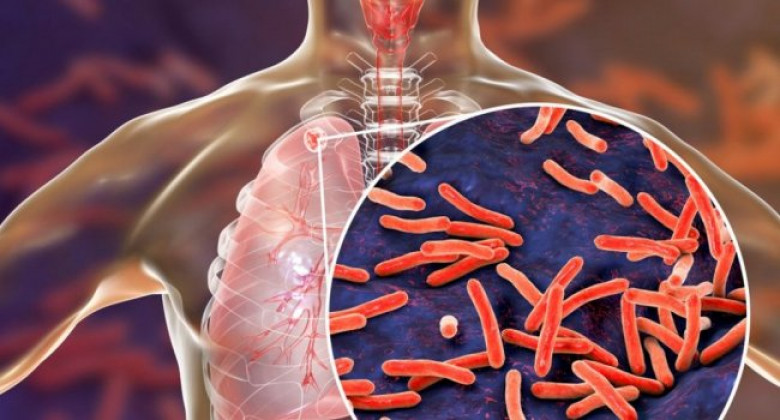Scientists explain emergence of especially dangerous pathogens of tuberculosis
LIFE
In a new study, published in the journal Bioorganic Chemistry, scientists have explained why Mycobacterium tuberculosis survives in inappropriate environmental conditions inside the human body.
The results of this study may help to better understand the role of enzymes in bacteria in the development of resistance against the human immune system and drugs.
The authors of the study examined the crystal structure and function of rubredoxin B (RubB), a metalloprotein (a protein containing metal atoms) that ensures the proper functioning of cytochrome P450, another protein important for bacterial survival. Scientists have a hypothesis, according to which, tubercle bacilli have learned to switch rubredoxin into a mode that ensures the effective use of iron in conditions of iron deficiency, which is observed during the formation of granulomas (nodules) in the lungs.
As a result, it turned out that rubredoxin B is associated with heme monooxygenases, which are important for the metabolism of oxysterols (they play a signaling role in the maintenance of immunity) and the host's anti-tuberculosis drugs. In other words, M. tuberculosis has the ability to neutralize xenobiotics.
Previous research has shown that one of the cytochromes supported by RubB may act against SQ109, a promising potential drug for multidrug-resistant tuberculosis.
According to the WHO, every year around the world 10 million people fall ill with tuberculosis, and 1.5 million people die from it, which makes it the main infectious killer in the world. Particularly dangerous strains of the tubercle bacillus, which have appeared in recent decades, have multiple drug resistance, mainly antibiotics, which greatly complicates the treatment of the infection.

 Acba bank and France’s Proparco to continue strengthening their long-term strategic partnership
Acba bank and France’s Proparco to continue strengthening their long-term strategic partnership Team Holding Announces the Launch of Bond Placement. Underwriter - Freedom Broker Armenia
Team Holding Announces the Launch of Bond Placement. Underwriter - Freedom Broker Armenia
 Unibank Issues the First in Armenia Perpetual Bonds
Unibank Issues the First in Armenia Perpetual Bonds
 Team Holding Announces the Launch of Bond Placement. Underwriter - Freedom Broker Armenia
Team Holding Announces the Launch of Bond Placement. Underwriter - Freedom Broker Armenia
 AraratBank Joins Armenia's New Greening Initiative: 100 Hectares of New Forest within Three Years
AraratBank Joins Armenia's New Greening Initiative: 100 Hectares of New Forest within Three Years Apply for a Unibank salary card and get a chance to win 1 000 000 AMD
Apply for a Unibank salary card and get a chance to win 1 000 000 AMD Euromoney Names Ameriabank Armenia’s Best Bank for Real Estate for the Second Year in a Row
Euromoney Names Ameriabank Armenia’s Best Bank for Real Estate for the Second Year in a Row
 S&P Global Ratings has assigned IDBank CJSC a long-term rating of “BB-” and a short-term rating of “B” with a “stable” prospect
S&P Global Ratings has assigned IDBank CJSC a long-term rating of “BB-” and a short-term rating of “B” with a “stable” prospect An unprecedented Evening for the Armenian Fashion and Hospitality Industry: World-Renowned Dress Designer Jacob Meyer Presents His Masterpieces at the ONE&ONLY Antigravity Theatre in The Dvin Hotel
An unprecedented Evening for the Armenian Fashion and Hospitality Industry: World-Renowned Dress Designer Jacob Meyer Presents His Masterpieces at the ONE&ONLY Antigravity Theatre in The Dvin Hotel A Brand-New Section on Idram&IDBank
A Brand-New Section on Idram&IDBank Several real and profitable offers ahead of Black Friday: IDBank and Idram
Several real and profitable offers ahead of Black Friday: IDBank and Idram AraratBank Joins Social Impact Award 2025 Summit in Ljubljana
AraratBank Joins Social Impact Award 2025 Summit in Ljubljana IDBank issued the 1st tranche of bonds of 2026
IDBank issued the 1st tranche of bonds of 2026 Ucom Supports the Development of Space Engineering in Armenia
Ucom Supports the Development of Space Engineering in Armenia
 Prioritizing Information Security: IDBank and Idram Support APOCALYPSE CTF 2025
Prioritizing Information Security: IDBank and Idram Support APOCALYPSE CTF 2025 IDBank's Representative, Innesa Amirbekyan Appointed Co-Chair of the ICC Banking Commission Task Force on Guarantees
IDBank's Representative, Innesa Amirbekyan Appointed Co-Chair of the ICC Banking Commission Task Force on Guarantees Ucom General Director Ralph Yirikian Awards Certificates to Participants of Cybersecurity Training Course
Ucom General Director Ralph Yirikian Awards Certificates to Participants of Cybersecurity Training Course
 Acba and Proparco mark one year of partnership, strengthening rural financing and Armenias’s economic resilience
Acba and Proparco mark one year of partnership, strengthening rural financing and Armenias’s economic resilience AraratBank and Arca's joint campaign has ended
AraratBank and Arca's joint campaign has ended IDBank: A Pioneer of Digital Banking and Innovation in Armenia
IDBank: A Pioneer of Digital Banking and Innovation in Armenia GRAWE Group and C-Quadrat Investment Group have announced plans to acquire 100% of LIGA Insurance Company in Armenia
GRAWE Group and C-Quadrat Investment Group have announced plans to acquire 100% of LIGA Insurance Company in Armenia
 Ucom Supports the Annual “Capture the Flag 2025” Cybersecurity Competition
Ucom Supports the Annual “Capture the Flag 2025” Cybersecurity Competition
 Financially Literate with Idram and IDBank: Next Stop – Nairi Camp
Financially Literate with Idram and IDBank: Next Stop – Nairi Camp Idram received a permit to establish and operate the Armenian payment and settlement QR system IdramNet
Idram received a permit to establish and operate the Armenian payment and settlement QR system IdramNet Ucom Completes the Deployment of its 5G Network Across All Cities of Armenia
Ucom Completes the Deployment of its 5G Network Across All Cities of Armenia
 Firebird, Inc. Secures U.S. Export License and Announces Dell Technologies as a Technology Partner, Establishing Major Milestones in Armenia’s AI and Digital Future
Firebird, Inc. Secures U.S. Export License and Announces Dell Technologies as a Technology Partner, Establishing Major Milestones in Armenia’s AI and Digital Future IDBank Receives Permission to Open a Representative Office in the United States
IDBank Receives Permission to Open a Representative Office in the United States RoboTon 2025 Competition Held with Idram’s Sponsorship
RoboTon 2025 Competition Held with Idram’s Sponsorship “Armenian potential in Spain: Arman Mayilyan as a guest on the ‘Armenian Diaspora Communities’ program.”
“Armenian potential in Spain: Arman Mayilyan as a guest on the ‘Armenian Diaspora Communities’ program.”
 Final Results of the 20th Annual International Microelectronics Olympiad Announced
Final Results of the 20th Annual International Microelectronics Olympiad Announced Unibank's VISA DIGITAL cards are now free
Unibank's VISA DIGITAL cards are now free
 Arca National Payment System, Bank of Georgia and Ameriabank Signed a Memorandum of Understanding
Arca National Payment System, Bank of Georgia and Ameriabank Signed a Memorandum of Understanding Idram has been awarded the prestigious “Beyond Payments Awards” by Ant International
Idram has been awarded the prestigious “Beyond Payments Awards” by Ant International STEM Acceleration Award 2025 Held with Idram’s Support
STEM Acceleration Award 2025 Held with Idram’s Support Solar Power is Generated in Kechut Community Through the Efforts of
Ucom and SunChild
Solar Power is Generated in Kechut Community Through the Efforts of
Ucom and SunChild
 Idram Announces Partnership with WeChat Pay
Idram Announces Partnership with WeChat Pay AraratBank: Transfer Your Mortgage Loan and Repay It on Attractive Terms: JOIN US
AraratBank: Transfer Your Mortgage Loan and Repay It on Attractive Terms: JOIN US “The Power of One Dram” as the Main Supporter of the National Hackathon AI4Biodiversity: AI Solutions for Nature
“The Power of One Dram” as the Main Supporter of the National Hackathon AI4Biodiversity: AI Solutions for Nature Speed-Mentoring Event Accelerates Green Innovations within the Ucom Fellowship Program
Speed-Mentoring Event Accelerates Green Innovations within the Ucom Fellowship Program
 Ucom Supports the Development of High-Tech Education in Armenia
Ucom Supports the Development of High-Tech Education in Armenia
 Dalan Technopark announces its first bond issuance. Placement Partner is Cube Invest
Dalan Technopark announces its first bond issuance. Placement Partner is Cube Invest Idram Junior Participants Receive Prizes: The First Junius Financial Literacy Competition Concludes
Idram Junior Participants Receive Prizes: The First Junius Financial Literacy Competition Concludes Lusine Yeghiazaryan joins the Board of Trustees of the Music for the Future Foundation
Lusine Yeghiazaryan joins the Board of Trustees of the Music for the Future Foundation 5,312,038 AMD for “Symphonic Forest”: the November beneficiary is AI4Biodiversity: AI Solutions for Nature, a national hackathon
5,312,038 AMD for “Symphonic Forest”: the November beneficiary is AI4Biodiversity: AI Solutions for Nature, a national hackathon Ucom’s Green Initiative Reaches Urtsadzor
Ucom’s Green Initiative Reaches Urtsadzor
 AraratBank Honoured with STP Award by Commerzbank AG
AraratBank Honoured with STP Award by Commerzbank AG
 Compelling Business Loan Offer from AraratBank: JOIN US
Compelling Business Loan Offer from AraratBank: JOIN US
 AraratBank – Title Sponsor of Urartu Football Club
AraratBank – Title Sponsor of Urartu Football Club  The interview of Mher Abrahamyan, Chairman of the Board of IDBank, to Khaleej Times
The interview of Mher Abrahamyan, Chairman of the Board of IDBank, to Khaleej Times Ameriabank’s Corporate Loan Portfolio Surpasses AMD 1 Trillion
Ameriabank’s Corporate Loan Portfolio Surpasses AMD 1 Trillion






